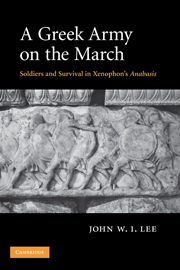Book contents
- Frontmatter
- Contents
- List of illustrations
- List of tables
- Preface
- Acknowledgments
- Abbreviations, transliterations, and other conventions
- Chapter 1 Introduction
- Chapter 2 The march route
- Chapter 3 The army
- Chapter 4 Unit organization and community
- Chapter 5 The things they carried
- Chapter 6 Marching
- Chapter 7 Resting
- Chapter 8 Eating and drinking
- Chapter 9 The soldier's body
- Chapter 10 Slaves, servants, and companions
- Chapter 11 Beyond the battlefield
- Tables
- Bibliography
- Index
Chapter 10 - Slaves, servants, and companions
Published online by Cambridge University Press: 22 September 2009
- Frontmatter
- Contents
- List of illustrations
- List of tables
- Preface
- Acknowledgments
- Abbreviations, transliterations, and other conventions
- Chapter 1 Introduction
- Chapter 2 The march route
- Chapter 3 The army
- Chapter 4 Unit organization and community
- Chapter 5 The things they carried
- Chapter 6 Marching
- Chapter 7 Resting
- Chapter 8 Eating and drinking
- Chapter 9 The soldier's body
- Chapter 10 Slaves, servants, and companions
- Chapter 11 Beyond the battlefield
- Tables
- Bibliography
- Index
Summary
That the structures of lochos and suskenia were central to the lives of the Cyreans should by now be quite clear. So far, our focus has been on the mercenaries themselves, but they were not the only people who made the trek from Mesopotamia to the sea. It is time to examine the place of non-combatants, including slaves, servants, and male and female companions, in the army.
A CYREAN'S WORK IS NEVER DONE
Sometime in January 400 bc the Cyreans reached the Black Sea coast at Trapezus. Having celebrated their arrival with athletic games, they assembled to deliberate their future. First to stand was Leon of Thurii, an ordinary soldier, who had this to say:
Well, men, as far as I'm concerned I've had enough of packing up and marching and running and carrying my weapons and advancing in formation and standing guard and fighting; I now desire to put a stop to all these toils, since we have reached the sea, and to sail the rest of the way and so arrive in Greece stretched out on my back like Odysseus.
The assembly roared in approval. A second Cyrean rose to voice similar sentiments, followed by another, then another. Indeed, every man who stood up to speak reiterated what Leon said. The troops' reaction was hardly surprising. Nearly a year, after all, had elapsed since Cyrus had led them out from Sardis.
- Type
- Chapter
- Information
- A Greek Army on the MarchSoldiers and Survival in Xenophon's Anabasis, pp. 255 - 275Publisher: Cambridge University PressPrint publication year: 2008



